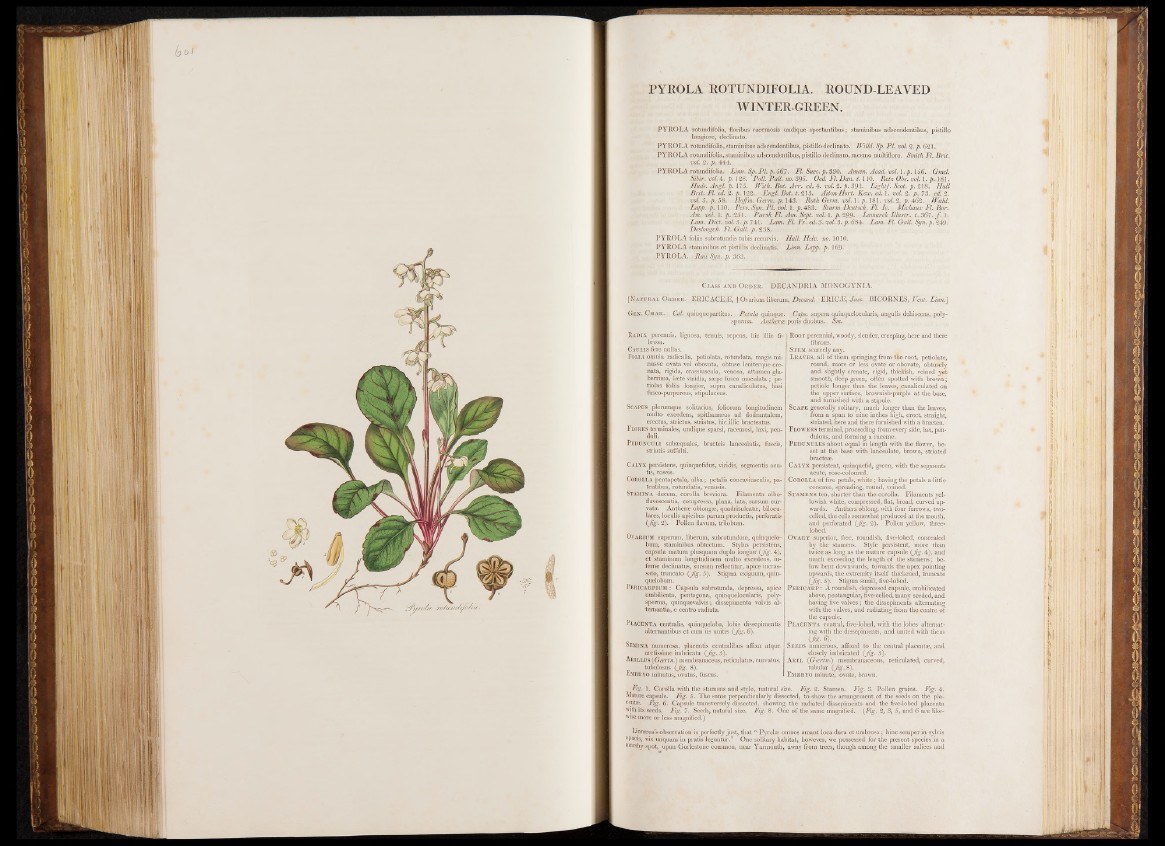
'raÙ M u/ÿfrfitct
R3B33BSGS&1S
PYROLA ROTUNDIFOLIA. ROUND-LEAVED
WINTERGREEN.
PYROLA rotundifolia, floribus racemosis undique spectantibus; staminibus adscendentibus, pistillo
longiore, declinato.
PYROLA rotundifolia, staminibus adscendentibus, pistillo declinato. Willd. Sp. PI. ml. 9.. p . 69,1.
PYROLA rotundifolia, staminibus adscendentibus, pistillo declinato, racemo multifloro. Smith Fl. B rit,
ml. 2. p . 444.
PYROLA rotundifolia. Linn. Sp. P i. p. 567. Fl.Suec.p. 330. Amcen. Acad. ml. 1. p. 156. Gmel.
Sibir. ml. 4. p. 128. Poll. Pall. no. 395. Oed. Fl. D an. 1. 110. Retz Obs. ml. 1. p. 181,
Huds. Angl. p. 175. With. Bot. A rr. ed. 4. ml. 2. p. 391- Lightf. Scot. p . 218. Hull
Brit. Fl. ed. 2. p. 122. Engl. Bot. t. 213. Alton Hort. Kew. ed. 1, ml. 2. p . 73. ed. 2.
ml. 5. p . 58. Hoffm. Germ. p. 143. Roth Germ. ml. 1 . p. 18 1 . ml. 2. p. 462. Wahl.
Lapp. p. 110. Pers. Syn. PI. ml. I. p. 483. Sturm Deutsch. Fl. Ic. Michaux Fl. Bor.
Am. ml. 1. p. 251. Pursh Fl. Am. Sept. ml. 1 . p. 299. Lamarck Illustr. t. 367. ƒ I.
. Lam. Diet. ml. 5. p. 741. Lam. Fl. Fr. ed. 3. ml. 3. p. 684. Lam. Fl. Gall. Syn. p , 249-
Deslongch. Fl. Gall. p. 238. ■
PYROLA foliis subrotundis tubis recurvis. Hall. Helm. no. 1010.
PYROLA staminibus et pistillis declinatis. Linn. Lapp. p . 169.
PYROLA. Rail Syn. p. 363. •
Class and O rd er. DECANDRIA MONOGYNIA.
[Natural Ord e r . ERICACEAE, f Ovarium liberum, Decand. ERICjE, J uss. BICORNES, Vent. Linn.]
Gen . Char. Cal. quinquepartitus. Petala quinque. .Caps, supera quinquelocularis, angulis dehiscens, poly-
sperma. Antherte poris duobus. Sm.
Radix, perennis, lignosa, tenuis, repens, hie illic fi-
' brosa.
Caulis fere nullus!
Folia omnia radicalia, petiolata, rotundata, magis mi-
nusve ovata vel obovata, obtuse leniterque.cre-
nata, rigida, crassiüscula, venosa, attamen gla-
berrima,-læte viridia, sæpe fiasco maculata ; pe-
tiolus foliis longior, supra canaliculatus, basi
- , fusco-purpureus, stipulaceus.
Scapus plerumque solitarius, foliorum longitudinem
multo excedens, spithamæus ad dodrantalem,
. erectus, strictus, striatus, hie .illic bracteatus.
Flores terminales, undique'sparsi, racemosi, laxi, pen-
duli.
Pedunculi subæquales, bracteis lanceolatis, fuscis,
striatis suffulti.
Calyx persistens, quinquefidüs, viridis, segmentis acu-
tis, roseis.
Corolla pentapetala, alba ; petalis concaviusculis, pa-
tentibus, rotundatis, venosis.
Stamina decern, corolla breviora. Filamenta albo-
flavescentia, compressa, plana, lata, sursum cur-
vata. Antheræ oblongæ, quadrisulcatæ, bilocu-
• lares, loculis apicibus parum productis, perl'oratis
(Jig. 2). Pollen flavum, trilobum.
Ovarium superum, liberum, subrotundum, quinquelo-
bum, staminibus obtectum. Stylus persistens,
capsula mature. plusquam duplo longior (Jig. 4),
et staminum longitudinem multo excedens, in- j
feme declinatus, sursum reflectitur, apice incras-
sato, truncato (Jig: 5). ’ Stigma exiguum, quin- j
quelobum.
Pericarpium : Capsula subrotunda, depressa, apice
umbilicata, pentagon», quinquelocularis, poly- j
sperm», quinquevalvis ; dissepiment» valvis al-
ternantia, e centro radiata.
Placenta centralis, quinqueloba, lobis dissepimentis
altemantibus et cum iis unitis (fig. 6)-
Semina numerosa, placentis centralibus affixa atque
arctissimc imbricata (Jig. 5).
Arillus (Goertn.) membranaceus, reticulatus, curvatus,
tubulosus (fig. 8).
Embryo minutus, ovatus, fuscus.
I Root perennial, woody, slender, creeping, here and there
fibrous.
Stem scarcely any.
Leaves, all of them springing from the root, petiolate,
round, more or less ovate or obovate, obtusely
and slightly crenate, rigid, thickish, veined yet
smooth, deep green, often spotted with brown;
petiole longer than the leaves, „canaliculated on
the upper surface, brownish-purple a t the base,
and furnished with a stipule.
Scape generally solitary, much longer than the leaves,
from a span to nine inches high, erect, straight
striated, here and there furnished with a bractea.
Flowers terminal, proceeding from every side, lax, pendulous,
and forming a raceme.
Peduncles about equal in length with the flower, beset
at the base with lanceolate, brown, striated
bracteas.
Calyx persistent, quinquefld, green, with the segments
acute, rose-coloured.
Corolla of five petals, white; having the petals a little
concave, spreading, round, veined.
Stamens ten, shorter than the corolla. Filaments yellowish
white, compressed, flat, broad, curved upwards.
Anthers oblong, with four furrows, two-
celled, the cells somewhat produced at the mouth,
and perforated (fig . 2). Pollen yellow, three-
lobed.
Ovary superior, free, roundish, five-lobed, concealed
by the stamens. Style persistent, more than
twice as long as the mature capsule (fig. 4), and
much exceeding the length of the stamens; below
bent downwards, towaids the apex pointing
upwards, the extremity itself thickened, truncate
(fig. 5). Stigma small, five-lobed. •
Pe r ica rp : A roundish, depressed capsule, umbilicated
above, pentangular, fivé-celled, many seeded, and
having five valves; the dissepiments alternating
with the valves, and l'adiating from the centre of
thé capsule',;
P lacenta central, five-lobed, with the lobes alternating
with the dissepiments, and united with them
o %■<>)• W Ê K Ê
Seeds numerous, affixed to the central placentae, and
closely imbricated (fig. 5).
Ar il (Gartn.) membranaceous, reticulated, curved,
tubular (fig. 8).
Embryo minute, ovate, brown.
Fig. l. Corolla with the stamens and style, natural size. Fig. 2. Stamen. Fig. 3. Pollen grains. Pig. 4.
Mature capsule. Fig. 5. The same perpendicularly dissected, to show the arrangement of the seeds on the placentae.
Fig. 6. Capsule transversely dissected, showing the radiated dissepiments and the five-lobed. placenta
with its seeds. Fig. 7• Seeds, natural size. Fig. 8. One of the same magnified. (Fig. 2, 3, 5, and 6 are likewise
more or less magnified.)
Linnaeus’s observation is perfectly just, that “ Pyroloe omnes amant loca dura et umbrosa; hinc semper in sylvis
°pacis, vix unquam in pratis leguntur.” One solitary habitat, however, we possessed for the present species in a
marshy, spot, upon Gorlestone common, near Yarmouth, away from frees, tliough among the smaller salices and